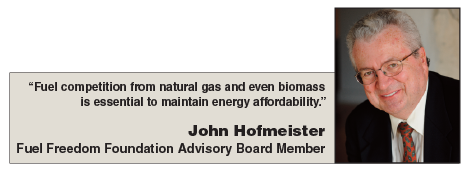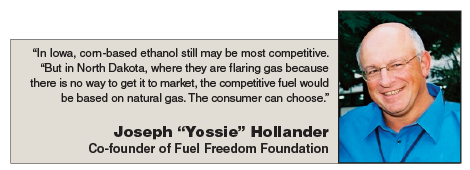
Transportation Options From Natural Gas Extend Well Beyond LNG, CNG
By Gregory DL Morris, Special Correspondent
IRVINE, CA.–This is the biggest business opportunity for oil and gas producers in the United States in many years,” says Joseph “Yossie” Hollander, who co-founded Fuel Freedom Foundation with Eyal Aronoff. The economic argument is as simple as it is compelling, he maintains. “Natural gas producers in the United States are selling their gas at $3-$4 a million Btu. Imported oil as a fuel, including cost of production, costs about $17 an MMBtu. That is a huge window of opportunity.”
The arithmetic is similarly evocative from a volumetric perspective, Hollander adds. “In 2011, gas producers in the United States achieved an increase of 1.7 trillion cubic feet over the previous year’s production. At prevailing prices of the time, that gas was worth close to $7 billion. If somehow that additional gas–not any other production, only the amount of increase–could have been converted to methanol to replace gasoline, the market value of that same volume of gas would have been $27 billion.”
Pausing a moment to let the reality of those numbers sink in, Hollander reiterates, “this is the biggest business opportunity to come along in a very long time.”
“Of course, as soon as we start talking about converting from gasoline, people immediately ask about oil.” He allows. “We understand that most independent producers–and all the majors–produce both oil and gas, so we do not have a bias for or against either gas or oil. All we are saying is that the current value divergence has created a business opportunity. That gap in value will close, or at least narrow, eventually.”
Taking another business angle, Hollander points to the stock prices of the global major companies. “Part of those stock values are from oil and part are from gas. They are not moving because of the natural-gas portion of their valuations.”
In the event of any significant natural gas demand growth, he suggests, gains from the gas portion of companies’ stock valuations would more than offset any decline from the oil portion.
Thinking Globally
When it comes to the subject of oil prices and their effects on company valuations, John Hofmeister can stake a legitimate claim as an authority. The former Shell Oil Co. president and member of FFF’s advisory board contends that global oil demand is sufficiently robust that even a big bump for motor fuels derived from natural gas and its derivatives in North America would register hardly a blip in the price of globally traded crude.
Hofmeister expresses understanding for producers’ concern about oil prices and recognizes their misgivings about any demand dampers in a gasoline market that has been no better than flat in recent years. He goes on to say he is especially sympathetic to inland independent producers whose lack of access to coastal ports forces them to accept sizable differentials, but notes that pipelines and crude-by-rail are broadening inland producers’ access to markets.
Ultimately, he urges, all produces should act locally but think globally. “Oil prices could be substantially higher,” Hofmeister reasons. “Global demand is growing faster than global supply. Where is the big new global supply? Offshore Brazil, East and West Africa, the Arctic. All are proving much more difficult to produce than first anticipated, both technically and geopolitically. Frankly, the price of oil is not doing very much, and in that kind of a market, the global majors are spending way too much capital on oil production.”
Underscoring Hollander’s assertion that North America needs every motor fuel source it can get, Hofmeister maintains that “Fuel competition from natural gas and even biomass is essential to maintain energy affordability.” To support that point, Hofmeister points to evidence showing that consumers shopping for a vehicle account its long-term cumulative fuel cost. “Recent consumer surveys have shown that a vehicle’s price is less critical than the life cycle fuel cost,” he reports. “That is a boon for oil and gas companies.”
That is because companies in the business already have infrastructure and market presence, Hofmeister indicates. Offering a mix of fuels tailored to the needs and conditions of each regional market provides suppliers the most pricing leverage, he describes, which again highlights the principle of acting locally while thinking globally.
There are plenty of sound economic and environmental reasons to pursue natural gas based fuels, he suggests, but the lure also comes with a lash. “The whole world is going to need the energy, specifically the oil, we are using,” he predicts. “Others are willing to outbid us for it.”
In short, he predicts North America has the opportunity to achieve energy self-sufficiency while greatly improving its energy efficiency, but developing economies, especially China and India, will continue to absorb a progressively greater share of global oil output. “China cannot stop the parade of cars and trucks onto its highways,” Hofmeister remarks. “Beijing is lining up to take the necessary oil. The Chinese already have invested $200 billion in cash into their national oil companies, and those companies have gone out into the world and bought rights to first oil.”
He lists Africa as a prime example where Chinese companies are making deals with NOCs. The same is true in Iran and Iraq. “From a geopolitical standpoint, China has got to have that oil, and it is going to get it one way or another,” Hofmeister assesses.
Although he says he prefers to avoid gloomy prophesies, Hofmeister predicts North American consumers will respond by driving less and flattening the continent’s gasoline demand. Nevertheless, he posits, consumption eventually will hit a floor, below which it cannot drop. “People have to drive to get to work, to school, to the store,” he remarks. “In a global market that is also willing to pay a lot more for gasoline, it is very unfair to ask the American consumer to cut back on other expenses to buy expensive fuels, when there are alternatives at hand. There is no need to depress the economy when we have options that other countries do not.”
Methanol And Ethanol
North America enjoys a wide range of options, Hollander assesses. “People think of natural gas as a motor fuel in terms of either compressed natural gas or liquefied natural gas, but natural gas also is a feedstock for methanol and ethanol,” he notes.
Hollander cites several gas-to-liquids projects in the works, including one by Celanese Corp. to convert natural gas to ethanol, and two by a firm called G2X Energy to convert natural gas to methanol and to gasoline.
Associated liquids constitute another meaningful economic factor, Hollander elaborates. “Natural gas liquids are deeply discounted because there is so much new production associated with unconventional gas,” he comments.
When natural gas prices first started to slide as shale gas swamped the market, Hollander recalls, wet gas fields gained favor over dry ones. Producers spoke of liquids as the profit and gas as a mere bonus, he describes, but then liquids prices also tumbled with overproduction.
“People are flaring ethane,” Hollander observes. “You cannot do anything with that in the refinery, and there is only so much that can go into petrochemical production. More steam crackers are being built, but that will take time. But ethane and other light liquids are great feedstocks for methanol.”
At the other end of the supply chain, Hollander asserts it costs about $300 to convert most existing cars to flex-fuel or multi-fuel capability. “Then they can use any combination of methanol, ethanol, or gasoline,” he reports.
According to Hollander, doing that on a significant scale will not require a big government program, mandate or subsidy, but can be driven by the private sector as a commercial venture. Reflecting on Hofmeister’s words about consumers’ focus on vehicles’ life cycle fuel costs, Hollander suggests the potential fuel savings quickly would pay for the one-time cost of a retrofit.
Flexible fuel vehicles also would allow regional and local markets to determine their preferred fuels, he says. “In Iowa, corn-based ethanol still may be most competitive,” he illustrates. “But in North Dakota, where they are flaring gas because there is no way to get it to market, the competitive fuel would be based on natural gas. The consumer can choose.”
Capital Comparisons
Steady demand and stable prices are best for both consumers and producers, Hofmeister remarks. Of course, sellers favor elevated prices and buyers prefer minimal ones, he acknowledges, but neither party likes volatility. High prices may offer a temporary windfall, he explains, but they destroy long-term demand. And when it comes to transportation fuels, he reflects, the stakes are higher because they undergird the entire economy.
“I know how oil and gas producers think and feel,” Hofmeister relates. “The most important thing to an oil and gas company is not the day-to-day commodity price ticking up or down, but the economy’s underlying strength. That means consumer and industrial demand. High fuel prices mean a weak economy. Do we want a strong economy based on competitive markets, or a limited economy that makes a profit on oil and loses its shirt on natural gas?”
Hofmeister adds that a competitive market for transportation fuels would prove a “big win for states and the federal government, with higher royalties and tax revenues, more jobs, better wages and thriving economies.” Even so, he emphasizes, “We are not talking about public investment, we are talking about private investment.”
While a boost in natural gas use for transportation does not necessarily entail a big public expense, it does call for a public policy shift, he suggests. “First, we need the U.S. Environmental Protection Agency to broaden the scope of fuels approved for the mass market,” Hofmeister assesses. “That does not take any tax dollars. We also need more flex-fuel vehicles. There is now a flex-fuel Ford F-150 pickup on the market, which is a great sign. But we also need retrofits.
“Once producers see that cars exist to use new fuels, once they see the demand is there to produce more of them, producers will rush to deliver that demand to the market,” he adds. “They will rush to invest in production and in the supply chain infrastructure.”
According to Hollander, converting one pump to supply methanol or another flex fuel costs around $100,000. Extrapolating that for all 160,000 U.S. retail gasoline locations comes to a relatively small $16 billion, he calculates.
That accumulated cost falls short of the capital investment required for one LNG export terminal, Hollander indicates, but investors continue to line up to back such facilities along the U.S. and Canadian coasts. In contrast to big new refineries or LNG terminals, massive new industrial facilities are not required to convert natural gas to methanol or other liquid fuels, Hollander says. “We don’t need a huge plant in the Bakken; there are mobile units that cost $20 million-$30 million,” he describes. “They can be used locally, and then moved to the next field. It is an option for even small companies.”
For other great articles about exploration, drilling, completions and production, subscribe to The American Oil & Gas Reporter and bookmark www.aogr.com.

















